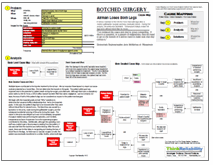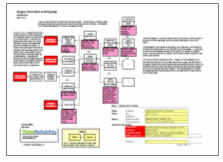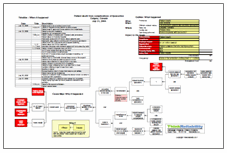By Kim Smiley
There have been a number of documented cases of people accidentally swallowing wire bristles from the brushes commonly used to clean grills. If ingested, the bristles can cause significant pain and have the potential to puncture organs, including the intestine which can lead to dangerous infections. There isn’t a lot of data available to determine how often this occurs, but a recent report discussing six cases of ingested wire bristles at a single hospital in a one year period hint that this may be more common than many realize.
 This issue can be analyzed by building a Cause Map or visual root cause analysis. The first step in creating a Cause Map is to determine how the issue impacts the overall goals of an organization. In this example, we’ll consider the organization the general public and the main impacted goal is the safety goal since there is a risk of serious health issues. Causes are now added to the Cause Map by asking “why” questions. Why is there a risk of serious health issues? Because there is the potential to swallow a wire bristle and the wire bristle can do a lot of damage within the body. (To view a high level Cause Map of this issue, click “Download PDF” above.)
This issue can be analyzed by building a Cause Map or visual root cause analysis. The first step in creating a Cause Map is to determine how the issue impacts the overall goals of an organization. In this example, we’ll consider the organization the general public and the main impacted goal is the safety goal since there is a risk of serious health issues. Causes are now added to the Cause Map by asking “why” questions. Why is there a risk of serious health issues? Because there is the potential to swallow a wire bristle and the wire bristle can do a lot of damage within the body. (To view a high level Cause Map of this issue, click “Download PDF” above.)
Continuing the “why” questions, we would now ask “why” is there a potential to swallow a wire bristle? This possibilities exists because people may inadvertently swallow the bristles without realizing it, the bristles come from wire brushes that are often used to clean residential grills and the bristles sometimes fall out of the brushes and stick to the grill. People may inadvertently ingest the bristles because the bristles can stick to meat and the texture can hide the presence of the bristle. Many people are also unaware of the potential danger of eating a wire bristle so they aren’t looking to find bristles. Investigation into this issue has not found any defects that are causing bristles to fall out. No one brand or type of grill brushes has been singled out as the culprit in these causes, but a worn grill brush is more likely to shed bristles than a new brush.
All six patients in the report did make full recoveries after treatment. In three of the cases, the wire bristles were stuck in the throat and required only laryngoscopic removal; the other three cases required more invasive surgery to remove the object.
The best way to protect yourself from the possibility of this occurring is to inspect the grill after using a wire grill brush or to find another method to clean your grill. The Consumer Product Safety Commission has asked that medical professions or consumers report any incidents of swallow grill brush bristles to http://www.saferproducts.gov to help monitor this issue.








